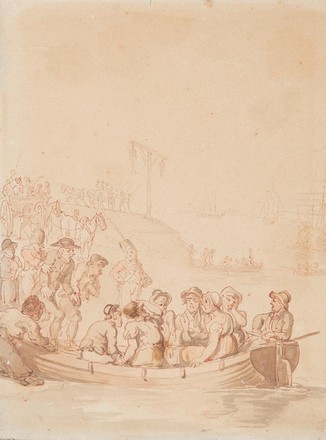Thomas Rowlandson (1757–1827) was a prolific artist in Georgian England. He painted
contemporary life on a rich array of topics, taking his inspiration from current
events and the activities of society, his works distinctive in their social
commentary and use of caricature.
Born in London, his father was bankrupt when
Rowlandson was two years old, and from this age he and his younger sister
Elizabeth went to live with his uncle and aunt. His artistic talent was encouraged,
and Rowlandson was admitted to the Royal Academy of Arts in 1772, aged only 15.
He sent his first exhibit to the annual
exhibition of the Royal Academy in 1775, and was enrolled there until 1778. He
travelled to Paris a number of times during his student years, although it is
uncertain if he studied whilst abroad.
Rowlandson’s satirical pen and wash drawings
exhibited a bawdy humour and astute sense of public taste. He turned his eye to a wide variety of places
and themes: the horseraces, the bar, the theatre, the pursuit of love, the
absurdity of politics. Elections were a particular interest of Rowlandson’s –
he enjoyed lampooning all contenders equally, and avoided one-sidedness or any
particular affiliations. His unique record of Georgian London shows both low
and high life, squalor and opulence. He poked fun at royalty, captured the
brawling crowds at boxing matches, and sketched the executions of notorious
criminals.
Rowlandson looked at life’s every angle for
comic material, producing thousands upon thousands of works over his career (there
is some suggestion that his prolific output was at least partially explained by
the demands of a gambling habit, which kept him in shabby housing despite his
artistic talent). For an extended period
of time he was employed as an illustrator for Rudolph Ackerman, producing
designs for books such as Loyal
Volunteers of London and Environs (1799), The Microcosm of London (1808–1810),
and The tour of Doctor Syntax:
in search of the picturesque(1812), all of which are available in
the Library’s printed book collections. Rowlandson was also employed to
illustrate for Caricature Magazine from
1806 to 1821.
Rowlandson’s keen interest in the political affairs of his time found
him drawing scenes relating to the transport of convicts – a
contentious issue at the turn of the 19th century in England.
Convicts embarking for Botany Bay
captures what would have been a common sight along the Thames and the English
coast at the time – convicts being rowed
out to ships bound for Australia. The Library holds another Rowlandson drawing,
A hulk at Sheerness, ca. 1800 (SV /
185), showing a converted prison ship (a hulk), most likely holding convicts
waiting for transportation.



 Back to list
Back to list